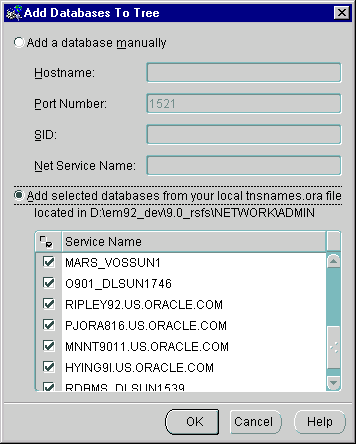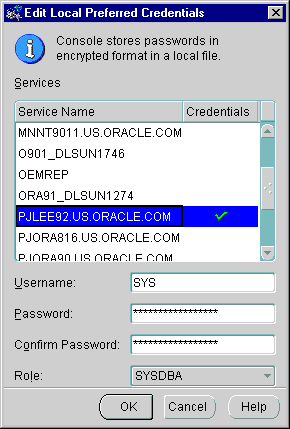Release 9.2.0
Part Number A96670-01
Home |
Book List |
Contents |
Index |
 Master Index |
 Feedback |
| Oracle Enterprise Manager Administrator's Guide Release 9.2.0 Part Number A96670-01 |
|
Beginning with Release 9.0 when you launch the Enterprise Manager Console or various other Enterprise Manager applications, you are prompted to choose between launching the product standalone (i.e. not connecting to the middle tier Management Server) or logging into a Management Server.
Launching the Console standalone allows a single administrator to perform simple database schema, instance, storage, security, and other database tasks by connecting directly to the target database(s).
Launching standalone does not require a middle tier Management Server or Intelligent Agents on target machines.
This chapter discusses the topics listed below:
When you launch the Enterprise Manager Console, you are prompted to choose between launching the product standalone or logging into a Management Server.
Choose to launch the Console standalone when you want to connect directly to your managed target(s) to perform administration tasks. With Enterprise Manager Release 9.0 the standalone Console only supports connecting directly to database targets, no other target types are currently supported.
Launching standalone does not require a Management Server or Intelligent Agents on managed targets. Consequently, when you launch the Console standalone, you do not have access to functionality typically available through the Management Server and Intelligent Agent, such as:
On Windows-based platforms, you start the Console from the Windows Start Menu.
You can also start the standalone Console from the command line using the command:
C:\> oemapp console
On UNIX platforms, you start the Console from the command line using the command:
$ oemapp console
When the dialog appears, choose "Launch standalone" and press OK.
To bypass the Console login, you can enter the following command at any supported operating system command line:
oemapp console oem.loginmode=standalone
By entering the command, you will immediately see the standalone Console.
If you are starting the standalone Console for the first time, the left panel of standalone Console is empty because you have not yet added the databases you want to manage. The Add Databases To Tree dialog appears automatically so that you can add them to the navigator tree.
The Add Databases To Tree dialog appears automatically when you start the standalone Console for the first time; it is also available from the Navigator menu.

Text description of the illustration add_db_t.gif
The Add Databases To Tree dialog allows you to manually enter the Net service names or add them from the local tnsnames.ora file.
You can add databases to the standalone Console navigator tree by manually filling in the following fields:
For example: ORCL.world.
.
|
Note: Adding a database manually automatically updates the local tnsnames.ora file located in your |
You can populate the standalone Console navigator tree by reading the database service names from the local tnsnames.ora file located in your Oracle Enterprise Manager home. The Add Databases To Tree dialog displays a list of databases identified in your tnsnames.ora file from which you can select or deselect. Click the column header to the left of Service Name to either select or deselect all the databases. If you have deselected all the databases, you can choose specific databases by selecting their checkboxes.
There are three ways to connect to a database for the standalone Console:
If no preferred credentials are set in the Oracle Enterprise Manager Console, the Database Connection Information dialog box appears. If preferred credentials are already set, you will connect to the database using this login information.
In the Database Connect Information dialog, enter the following information to connect to the database.
The Oracle username for the database to which you are connecting.
For example: system
The password for the username to which you are connecting.
For example: manager
You can select from a pull-down list whether you want to connect to the database with NORMAL, SYSOPER, or SYSDBA privileges. Select NORMAL to connect to the database as an ordinary user. Select SYSOPER to connect to the database with special operator privileges, such as capabilities to shut down and start up the database. Select SYSDBA to connect to the database as a user with full database privileges such as the capability to grant any privileges to any user.
To use SYSOPER and SYSDBA privileges, a password file or OS group authentication must be created and set up for your database.
|
Note: In 9i, the SYS account may only be used with SYSDBA or SYSOPER (not NORMAL). You also do not set up a password file as with previous database versions. |
Saving preferred credentials is an option which enables you to store login information in a local file such as username, password, and role (NORMAL, SYSOPER, or SYSDBA). Passwords are always stored in encrypted format.
This login information is used when a connection is established for the database instead of having to type a username and password each time.
You can set preferred credentials by selecting the Save As Local Preferred Credentials checkbox or you can save credentials later by using the Edit Local Preferred Credentials dialog available from the Configuration menu.
In the standalone Console, you do not have to disconnect as a user before reconnecting as a different user.
If you are already connected to a database and you want to reconnect as a different user
When the Database Connect Information dialog appears, enter a different username and press OK.
You will automatically be disconnected and reconnected.
When a connection is made to a database, a connection icon is displayed on top of the database icon in the standalone Console tree.
Next to the database name, you will see the username and role, if applicable, that you are connect as. For example, if you have connected as user SYS with the SYSDBA role, you should see "sys as SYSDBA."
To remove a database from the standalone Console navigator tree, follow the steps below:
When the Console is connected to an Oracle Management Server, the Console navigator tree is populated with the discovered databases.
The following steps describe how to copy these databases so they can be used in standalone mode.
The databases displayed in the navigator tree can be added to the tnsnames.ora file and their associated preferred credentials saved to a local file:
|
Note: The passwords are encrypted in the local file to prevent the file from being used on other machines. |
To make these databases available in standalone mode, you can perform the following steps:
|
Note: The passwords are encrypted in the local file, dbastudio-<os_username>.crd, so that they cannot be copied to another machine and used by a different user. |
The standalone Console stores a list of databases that are displayed in the standalone Console navigator tree. If preferred credentials are specified for any of these databases, the username, encrypted password, and role are added to the local file. The local record, dbastudio-<os_username>.crd, is located in the <Oracle_Enterprise_Manager_Home>/sysman/config/pref directory.
The login information is used when a connection is established to the database instead of having to type a username and password each time.
To save or edit the local preferred credentials of a service, you can perform the following steps:

Text description of the illustration edit_pc.gif
|
Note: You can save or overwrite the preferred credentials by selecting the "Save As Local Preferred Credentials" checkbox in the Database Connection dialog. |
After you have started the standalone Console, and you want to connect to a management server (switching therefore from standalone into distributed mode), you must close and restart the Console.
If you have been using standalone Console, the list of databases displayed in the navigator tree is retrieved from a local file.
At some stage in the future, you may decide to administer jobs, events, and groups; run the database applications through a web browser; or perform backup and data management tasks. These tasks require you to run the Console connected to an Oracle Management Server.
If you now decide to run the Console connected to an Oracle Management Server, the databases displayed in the navigator tree may be different than those in standalone mode, because the list of databases is retrieved from the repository and not from a local file.
To add the databases that were available from the standalone Console, you will need to discover the services from the Oracle Enterprise Manager Console if the databases are not already available from the Console connected to the Oracle Management Server.
|
 Copyright © 1996, 2002 Oracle Corporation. All Rights Reserved. |
|